| LESSON: Discussing healthy habits and healthy living and learning about the food pyramid. | School: school №1 Kuryk village |
| DATE: | Teacher name: Igniyazova Aigul |
| Class: grade 7 | Present:12 | Absent:0 |
| Learning objectives | 7. 7. L4 understand with little support some of the implied meaning in extended talk on a limited range of general and curricular topics. S7 use appropriate subject-specific vocabulary and syntax to talk about a range of general topics, and some curricular topics. 7. UE8 use a growing variety of future forms including Present Continuous with future meaning on a range of familiar general and curricular topics. |
| Level of thinking skills | Higher order of thinking levels |
| Assessment Criteria | Apply topical vocabulary and syntax to communicate. Interpret with little support some of the implied meaning in extended talk. Use the future form including the Present Continuous with future meaning. |
| Lesson objectives | All learners will be able to: Most learners will be able to: Some learners will be able to: |
| Language objectives | Key words: Useful classroom language/dialogue What habits are healthy/ unhealthy? Food Pyramid, healthy/ unhealthy eating |
| Cross curricular links | Biology, The Kazakh Language. |
| Values links | respect, cooperation, hardworking |
| Previous learning | Natural disasters. Fill in the cluster. Cluster strategy. (W)   
  
Natural disaster
 
    

|
| Plan |
| Planned things | Planned activities | Resources |
| Start
8 min | Organizing moment. Greetings Dialogue with the duty Divide the students into 2 groups by the cards. Group I- Fruits Group II- Vegetables Brainstorming. (W) Look at the interactive board. What can you see in the picture? Showing pictures one by one to ask learners the questions: Strategy “Concept questions”
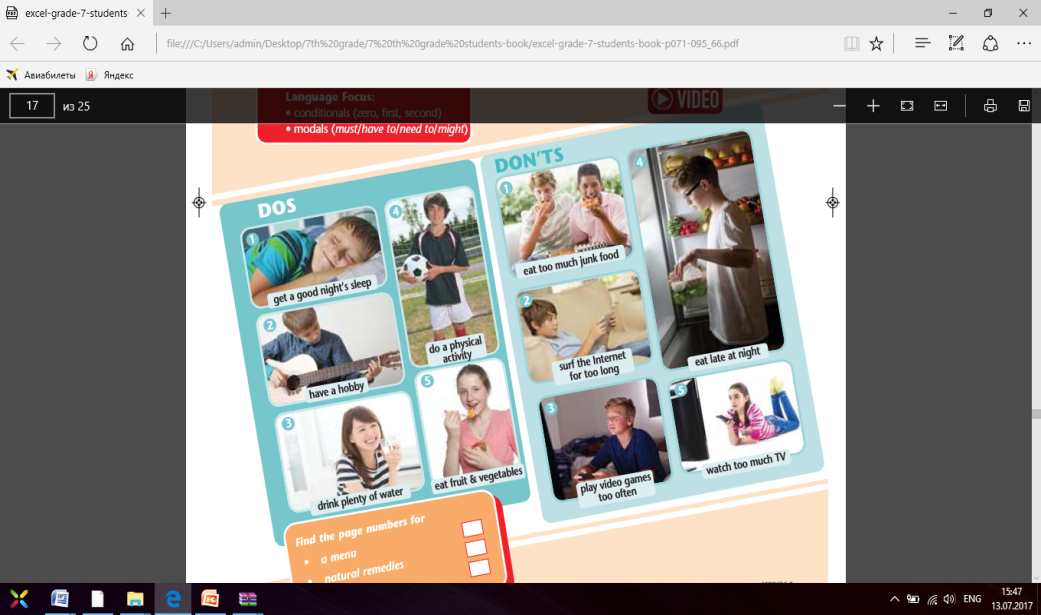
Presenting topical vocabulary with illustrated pictures. Health, healthy, fit, lifestyle, portion, ingredients, cereal.
|
Cards with suitable pictures.
Student`s book. P.87
|
| Middle
12 min | Listening. Pre-listening task. Strategy “Unscramble the words ” Rearrange the letters to make a word. (G) 1 group. Elhtah – health Triuf – fruit Odof – food 2 group. Yhetalh – healthy Tegveabel – vegetable Itf - fit Listening to the text “Fit and healthy”. (W)
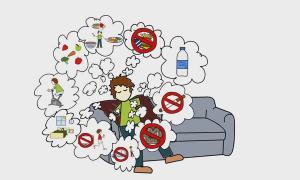 Fit and healthy These days, I feel a little bit lazy. It’s time to make some lifestyle changes! My friend Martin says that exercise and healthy eating are really important. I’m going to be more like Martin. I’m going to join the gym and get fit. I’m going to eat five portions of fruit and vegetables every day. Fruits and vegetables have many vitamins and minerals that our bodies need. I’m going to have three healthy meals – breakfast, lunch and dinner – and I’m going to cook all my food myself with fresh ingredients– no more fast food for me! I’m going to drink lots of water. I’m going to stop smoking. I’m going to stop going to the pub. I’m going to stop driving and start walking. I’m going to stop watching TV and start running. I’m going to go to bed early and get at least eight hours’ sleep every night. From now on, I’m going to be so healthy! …Tomorrow, I’m going to get fit and healthy… Post-listening task. (I) Fill the gaps with the missing words. I'm going to _____the gym and get fit. (join) I'm going to have three healthy_____ .(meals) No more_____ for me. (fast food) I'm going to drink lots of_____ (water) I'm going to stop______.(smoking) | cards
https://esol.britishcouncil.org/content/learners/.../listening
|
| Descriptor | A learner: |
|
| Assessment
| Formative assessment: pupils get figures | 0-1mistake | 2-3mistakes | 4or more | | 
| 
| 
|
| Colored cards |
|
10 min | Speaking. Now, learners what can you see on the board? 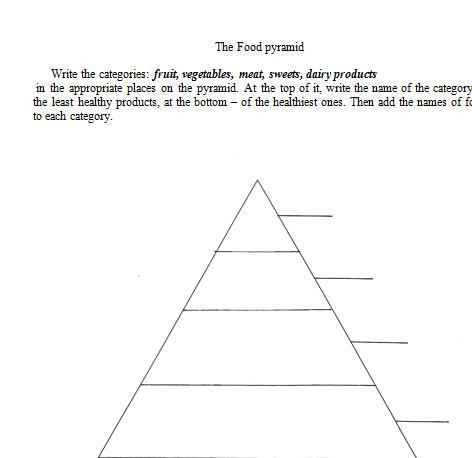
Food Pyramid is a diagram that represents a healthy diet by placing food groups in a pyramid according to the number of servings from each group to be eaten every day. Making a poster. (G) Each group draws a pyramid and fill the pyramid with different types of food. At the top of it, write the name of category the least healthy products, at the bottom- of the healthiest ones. Learners from each group show their pyramids and justify their answers. Others may comment and evaluate, or contradict. Tasks for more able learners : Answer the questions.
- What Food Group serves as the base of the Food Pyramid? Why? Tasks for less able learners: Mark the statements True or False. It is important to eat a variety of foods. (T) Bread contains vitamins and minerals. (T) All fatty foods are bad for us.(F) Learners are shown the original Food Pyramid 
|
PPT
Flipchart
Cards |
| Descriptor | A learner : |
|
|
Assessment
|
Formative assessment: Heads down, thumbs up. 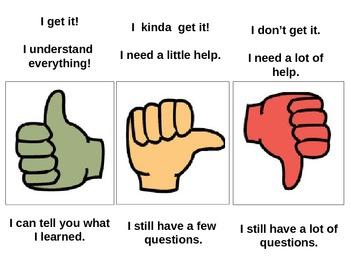  
|
|
|
10 min
| Use of English. Present Continuous with future meaning. 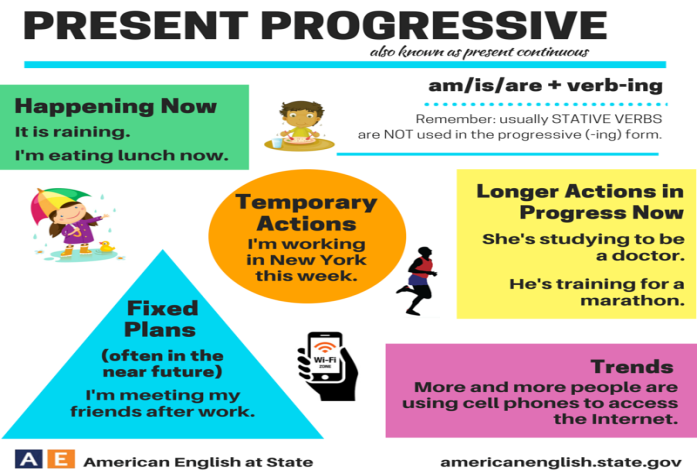 We can also use the present continuous (subject + 'be' = verb-ing) to talk about future plans. We usually use it when the plan is an ‘arrangement’ – more than one person is involved and we know the time and place. Example: I’m meeting Jane at 8 o’clock on Saturday. We use going to to talk about plans decided before the moment of speaking. Example: I am going to drink lots of water. You can use the present continuous for future plans with these words: tonight, tomorrow, this weekend next week/month/year this summer/fall/winter/spring on Monday/Tuesday/Wednesday/etc. next Monday/Tuesday/Wednesday/etc. Put the verb in the Present Continuous.( W) I`m really busy.- I ____(study) for the exam. They _____ (wait) for me in the café. The weather is terrible, so we ____(not go) walking much. We ____ going to join the gym. Our family _____ to go to London. (go) |
Americanenglish.state.com
|
| Descriptor
| A learner : |
|
| Assessment
| Formative assessment: pupils get emotional smileys. | 0-2mistakes | 3-4mistakes | 5or more | | 
| 
| 
|
| smiles |
| End
5 min | Feedback. Strategy “Draw your brain”. Learners draw outlines of brain, then they fill it with everything they have learnt during the lesson. 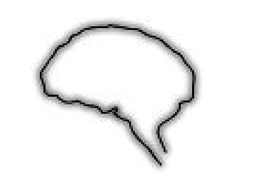
Homework: to write about healthy and unhealthy habits. |
|
| Additional Information |
|
| Differentiation-how do plan to give more support? How do you plan to challenge the more able learners? | Assessment-how are you planning to check learners learning?
| Cross-curricular links health and safety check ICT links Values links |
| Most support: Make sure that they try to justify personal opinions while giving the answers. Minimal support: Help less able learners with the marking sentences with True or False. |
| Criteria | 1 | 2 | 3 | 4 | | Makes the words correctly |
|
|
|
| | Completes the sentences |
|
|
|
| | Makes a poster |
|
|
|
| | Speaks on the topic |
|
|
|
| | Does grammar exercises |
|
|
|
| “excellent” –were able to ask and respondent answer to questions used vocabulary made sentences. “good” – the students made some errors in pronunciation, made some mistakes in two task. “satisfied” – the students made more errors in pronunciation, made 5-6 mistakes in each tasks. 20-18=excellent 17-15=good 14-12=satisfactory
| Friendly atmosphere in class. Using ICT pupils used to work systematically and faster than at ordinary lesson . Cross-curricular links with Biology, The Kazakh Language. Values links: during the lesson learners are educated to be hardworking, be respectfully to each other. |
| Reflection Were the lesson objectives/learning objectives realistic? Did all the learners achieve lesson objectives/learning objectives? Did my planned differentiation work well? Did I stick to timings? What changes did I make from my plan and why? |
The lesson objectives/learning objectives were realistic. Learners achieved lesson and learning objectives. All learners were involved in the learning process. Learning atmosphere was collaborative and friendly. I am sure that my planned differentiation work well. Differentiated task helped to involve all learners to the lesson. Learners learnt how to work in groups, to make decisions, to learn what they didn’t know before and shared their knowledge. Passive students started to strive forward. Students took more time in preparing a poster. I would keep on improving my skills on working by criteria based system. Finally, I want to say learners need to be motivated to succeed in learning any language. Therefore, teaching materials must be motivating and raise learners interest.
|
|
| Summary evaluation What two things went really well (consider both teaching and learning)? What two things would have improved the lesson (consider both teaching and learning)? What have I learned from this lesson about the class or individuals that will inform in my next lesson? |







































